The organ in northern Europe during the sixteenth century is typified by the instruments of the low countries and Germany. In the region that now encompasses the Netherlands and Belgium, and throughout the region north of the Alps, these organs usually consisted of two or more divisions. To put it more strongly,
From the sixteenth century on, organs of northern Europe (as opposed to Italianate organs) are identified by their inclusion of at least two contrasting divisions.Although one-manual instruments without pedal were certainly built, they were in the minority, and the intentional inclusion of separate divisions is the normal condition against which others are judged when studying sixteenth-century organs of northern Europe.
| Top
of Page Divisions and Names | Stops and Timbre Tonal Disposition | Registration | Enlarged Images Review Quiz |
The primary division of these organs was the Hauptwerk, to use the German term that has become standard. 113 The windchest for the Hauptwerk forms a major architectural component in an organ case of this period, and it was placed at some height above the keydesk; trackers communicated the motion of the keys through a roller board to the individual pallets of the chest.
The diagram to the right shows the usual arrangement of chest and pipes in such instruments. The front pipes (the praestants) are shown in red and purple, and their placement is typical of northern organs of the sixteenth century:
|
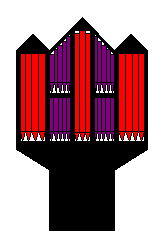 |
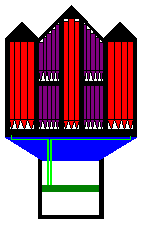 The chest of the Hauptwerk forms an impost, a horizontal structural element over two supporting members, shown as thick black lines in the diagram to the left, the extremes of the chest usually extending beyond the supports of the base.
The chest of the Hauptwerk forms an impost, a horizontal structural element over two supporting members, shown as thick black lines in the diagram to the left, the extremes of the chest usually extending beyond the supports of the base.
The blue space in the diagram represents the roller board, and the bright green lines lead from two hypothetical keys (on the dark green keyboard) through vertical trackers and horizontal rollers to pipes at either extreme.
In many instruments, secondary manual divisions were included as both tonal additions to the Hauptwerk and as visible additions to the primary case. Second or even third divisions were built according to one of several designs that became standard through the course of the sixteenth century. The primary division was called the Haupt/Head, and secondary divisions received names that revealed their relationship to the Hauptwerk in terms of physical position. The three most common were:
 The drawing to the right is a diagram of the typical appearance of one of these instruments. The blue area is the space where a Brustwerk chest and pipes would be placed. This division was usually played through a keyboard placed above that of the Hauptwerk. The overall shape of one of these cases - - with a top wider than the base, has been compared to the shape of a tulip blossom, as the animation shows.
The drawing to the right is a diagram of the typical appearance of one of these instruments. The blue area is the space where a Brustwerk chest and pipes would be placed. This division was usually played through a keyboard placed above that of the Hauptwerk. The overall shape of one of these cases - - with a top wider than the base, has been compared to the shape of a tulip blossom, as the animation shows.
 The
cases typically had two pairs of doors, or shutters, which could be closed over
the Hauptwerk and the Brustwerk respectively. The photograph to
the left is of the 1526 organ from the Hervormde Kerk in Scheemda, The
Netherlands, now an empty case in the Rijksmuseum, Amsterdam. The doors are
in their open position, and a high degree of decoration in the form of painting
for the doors and carving on the casework is evident. Peter Williams has suggested
that the space between the keydesk (immediately above the curtained rail) and
the impost level could have been used for a Brustwerk or a regal.115
The
cases typically had two pairs of doors, or shutters, which could be closed over
the Hauptwerk and the Brustwerk respectively. The photograph to
the left is of the 1526 organ from the Hervormde Kerk in Scheemda, The
Netherlands, now an empty case in the Rijksmuseum, Amsterdam. The doors are
in their open position, and a high degree of decoration in the form of painting
for the doors and carving on the casework is evident. Peter Williams has suggested
that the space between the keydesk (immediately above the curtained rail) and
the impost level could have been used for a Brustwerk or a regal.115
When a second manual division larger than a Brustwerk was included in a sixteenth-century organ in the north, its name usually indicated its position in the case:
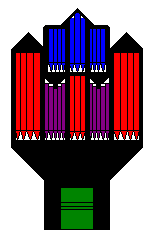 An
Oberwerk was placed above the Hauptwerk, with its Praestant
pipes in the same vertical plane as those of the Hauptwerk. The keyboard
of the Oberwerk was generally placed above that of the Hauptwerk,
and if a Brustwerk were also present, between that of the Hauptwerk
and the Brustwerk.116 This division is more common in organs of the
lowlands than in Germany.
An
Oberwerk was placed above the Hauptwerk, with its Praestant
pipes in the same vertical plane as those of the Hauptwerk. The keyboard
of the Oberwerk was generally placed above that of the Hauptwerk,
and if a Brustwerk were also present, between that of the Hauptwerk
and the Brustwerk.116 This division is more common in organs of the
lowlands than in Germany.
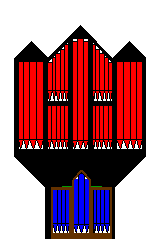 A Rückpositiv
was placed behind the player, and it was often built into the rail of the gallery
on which the organ was located. The animation to the right illustrates the relationship
between Rückpositiv (in blue and brown) and the main case (in red
and black) by showing the two from several different angles. As in the similar
diagrams above, the space for the keyboards is shown by a green rectangle with
two black bars. 117 The keyboard of a Rückpositiv was
placed below that of the Hauptwerk, so that stickers
could run from the keys down and under the players bench or stool. That way
they did not interfere with the trackers for any manuals and divisions placed
above it. In sixteenth-century Germany, this division was more common than an
Oberwerk.
A Rückpositiv
was placed behind the player, and it was often built into the rail of the gallery
on which the organ was located. The animation to the right illustrates the relationship
between Rückpositiv (in blue and brown) and the main case (in red
and black) by showing the two from several different angles. As in the similar
diagrams above, the space for the keyboards is shown by a green rectangle with
two black bars. 117 The keyboard of a Rückpositiv was
placed below that of the Hauptwerk, so that stickers
could run from the keys down and under the players bench or stool. That way
they did not interfere with the trackers for any manuals and divisions placed
above it. In sixteenth-century Germany, this division was more common than an
Oberwerk.
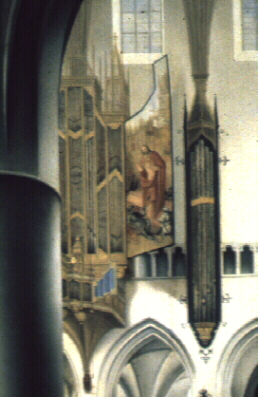 The Saenredam painting of the interior of the Haarlem Grote Kerk shows an organ with separate cases for the Hauptwerk and the Rückpositiv. In the painting, doors are shown in their open position on each case. The painting is discussed in more detail on the page on the fifteenth-century organ; a detail appears to the right.
The Saenredam painting of the interior of the Haarlem Grote Kerk shows an organ with separate cases for the Hauptwerk and the Rückpositiv. In the painting, doors are shown in their open position on each case. The painting is discussed in more detail on the page on the fifteenth-century organ; a detail appears to the right.
Pedal divisions were known in sixteenth-century northern Europe, but they were usually small in extent, and with the exception of bordunen in separate cases, they had no visible place in the cases.
| Top
of Page Divisions and Names | Stops and Timbre Tonal Disposition | Registration | Enlarged Images Review Quiz |
During the fifteenth century, great changes in musical style were developing and spreading gradually throughout Europe. For organ builders, these changes in musical style were felt in the sixteenth century as a demand for new sounds, and, as more instruments were built with stops for individual ranks of pipes, new stops were made that produced the desired timbres. Therefore, in addition to stops which descended from the older Blockwerk organ, stops with sounds new to the organ were built on sixteenth-century organs of northern Europe.
It is, then, in these organs of northern Europe that one sees the beginning of stoplists that name specific stops which were to become standard in organ dispositions in the centuries to follow. Although many variations in names can be found throughout the region, and although some of the stops that appeared had but a short life span, we can identify these stops by both name and timbre as being typical of this time and place:
| Top
of Page Divisions and Names | Stops and Timbre Tonal Disposition | Registration | Enlarged Images Review Quiz |
In summary, the tonal resources of these organs usually included:
These stops were usually disposed according to the following pattern:
Although some organs built during the sixteenth century were meant for secular purposes, the bulk of the surviving literature - - particularly that which is still performed today - - was composed for use in religious - - specifically, Christian services. Therefore, registration conventions for instruments of this period followed the musical demands of the music played on the organ for services in the churches where they were located. Through the course of the century, the period of the Reformation, many of these churches saw great changes in the musical requirements of their liturgies. Both the construction and the use of the instruments reflect these changing musical demands.
In the north, where instruments with contrasting divisions were and remained the normal type of organ, many of the registration indications that survive had to do with one of two types of instruction:
The extremely large size of some of these images means that loading them will take an unduly long time if you are viewing these pages through a modem connection.
© 1998, 1999 James H. Cook